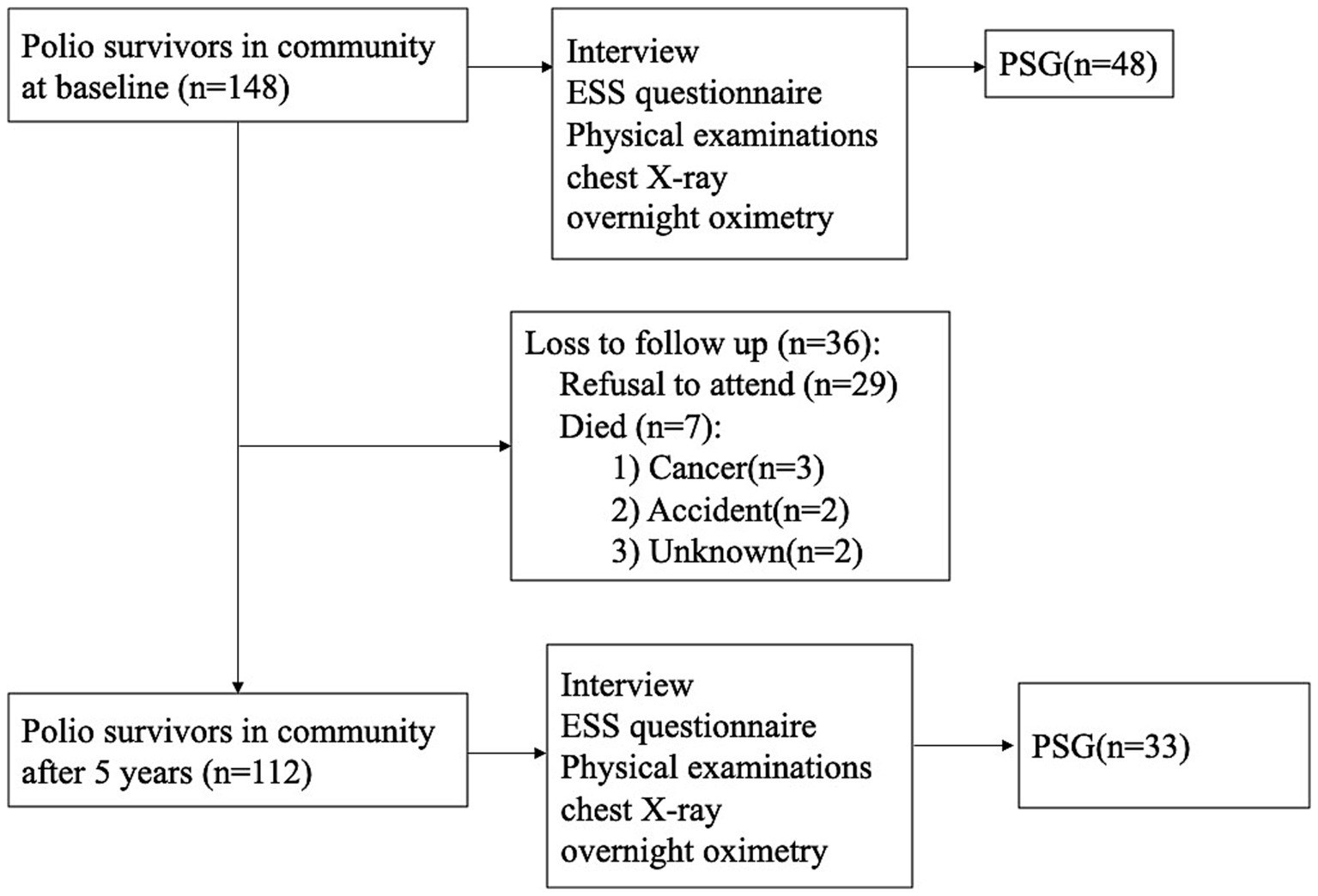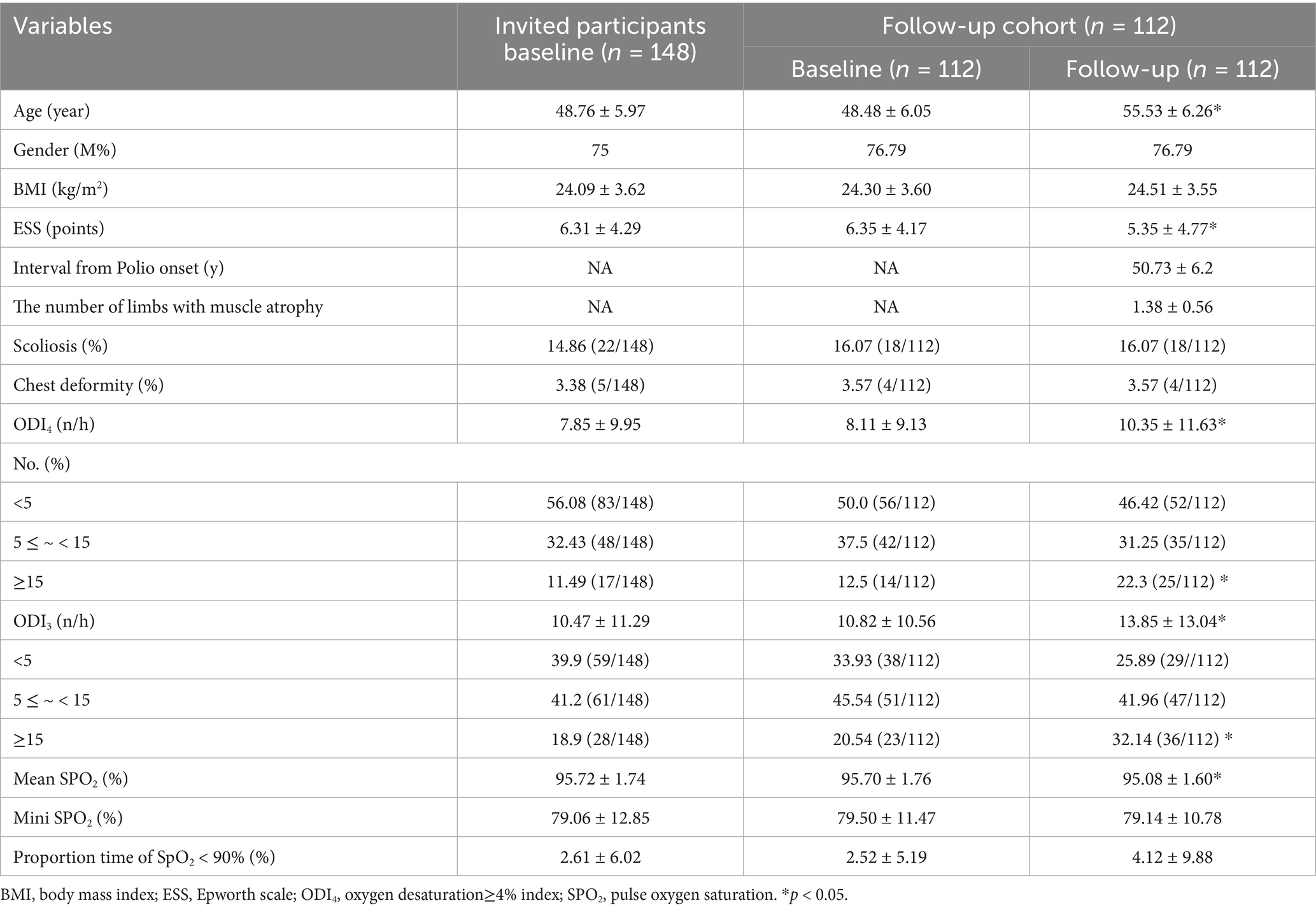- 1Department of Sleep Medicine, Peking University People’s Hospital, Beijing, China
- 2Department of Respiratory and Critical Care Medicine, Binzhou Medical University Hospital, Binzhou, Shandong, China
- 3Department of the First School of Clinical Medicine, Binzhou Medical University, Binzhou, Shandong, China
- 4Dongyang People's Hospital, Dongyang, Zhejiang, China
- 5Dongyang the Seventh People's Hospital, Dongyang, Zhejiang, China
- 6Division of Pulmonary, Critical Care and Sleep Medicine, Department of Medicine, Case Western Reserve University, and Cleveland Louis Stokes VA Medical Center, Cleveland, OH, United States
Purpose: Obstructive sleep apnea (OSA) is highly prevalent in polio survivors, but longitudinal data on its progression remain limited. This study aimed to characterize OSA progression in community-dwelling polio survivors and compare it with an age-matched control group.
Methods: A prospective 5-year longitudinal study recruited 148 polio survivors (48.76 ± 5.97 years, 75% male). At baseline (2014), all participants underwent overnight oximetry. Among them, 42 completed in-lab polysomnography (PSG) testing. Over the 5-year follow-up, 112 polio survivors (76.79% male, mean age 48.48 ± 6.05 years) were successfully tracked, with 33 undergoing follow-up PSG. Additionally, 59 age- and sex-matched OSA patients were enrolled as controls. Primary outcomes included changes in oxygen desaturation index ≥4% (ODI4) and apnea-hypopnea index (AHI). Correlates of OSA progression were analyzed using Pearson’s correlations.
Results: Over 5 years, ODI4 increased significantly in polio survivors from 8.11 ± 9.13 to 10.35 ± 11.63 events/h (p = 0.01), with a shift toward moderate–severe ODI4 (13 to 22%, p = 0.027). AHI also rose in both groups: polio survivors (26.57 ± 21.25 to 33.86 ± 22.43 events/h, p = 0.02) and controls (27.14 ± 21.91 to 37.24 ± 24.55 events/h, p = 0.004), with no significant group difference in AHI progression (p = 0.89). However, polio survivors showed increased mixed apnea index (p = 0.02) and prolonged REM sleep latency (p = 0.009). ODI4 changes correlated with scoliosis (r = 0.27, p = 0.005) and BMI fluctuations (r = 0.25, p = 0.008).
Conclusion: OSA-related parameters, particularly mixed apnea and REM alterations, progress in polio survivors. Changes in ODI4 were positively correlated with BMI fluctuations and scoliosis.
1 Introduction
Global estimates suggest 15–20 million polio survivors worldwide, with 2.8 million in China (1). Obstructive sleep apnea (OSA) prevalence among this population ranges from 7.3 to 65% (2), highlighting their substantial demographic presence and the growing public health burden of post-polio sequelae. Multiple mechanistic hypotheses have been proposed to explain OSA pathogenesis in polio survivors, including progressive respiratory muscle dysfunction, neuromuscular scoliosis-induced restrictive lung disease, pharyngeal dilator muscle impairment, upper airway narrowing, or combinatorial effects of these factors (3, 4). However, longitudinal evidence regarding OSA progression in this population remains scarce (5, 6).
Most prior studies on OSA in polio survivors have been cross-sectional and clinically based (7–9). This 5-year longitudinal study aimed to characterize OSA progression in a community-recruited cohort of polio survivors. By comparing outcomes with an age-matched general control group, we sought to determine the role of polio sequelae in OSA progression. To our knowledge, this represents the first longitudinal investigation of OSA in this population. We hypothesized that polio sequelae would be associated with accelerated OSA severity changes over the 5-year follow-up period.
2 Methods
This prospective 5-year longitudinal follow-up study was conducted from 2014 to 2019 in Dongyang City, Zhejiang Province, China. The study protocol was approved by the Institutional Review Board of Binzhou Medical University, and written informed consent was obtained from all participants.
2.1 Participants
Potential post-polio survivors (defined as individuals with poliovirus exposure >25 years prior) were identified in Dongyang City. We confirmed the history of polio infection through the registration records obtained through collaboration with the local branch of the China Disabled Persons’ Federation, a national agency dedicated to supporting individuals with chronic disabilities. And the time of infection was further determined through systematic interviews. Participants were excluded if they had undergone prior medical treatment for OSA.
2.2 Study design and data collection
In 2014, 148 community-dwelling individuals (48.76 ± 5.97 years, 75% male) with a confirmed history of poliomyelitis were recruited. Demographic and clinical data, including age, polio onset age, and sociodemographic factors, were collected via structured interviews. All participants completed the Epworth Sleepiness Scale (ESS) questionnaire. Height and weight were measured using standardized protocols. Medical histories were reviewed to exclude individuals taking sleep-altering medications. Physical examinations, electrocardiograms, chest radiographs, and laboratory tests (complete blood count and metabolic panel) were performed to exclude participants with uncontrolled severe medical conditions.
As depicted in Figure 1, all 148 participants underwent baseline overnight DS-5 oximetry (KONICA MINOLTA, Osaka, Japan), with 48 completing in-lab standard polysomnography (PSG; Alice series, Philips Respironics, USA). At 5-year follow-up, 112 polio survivors (76%) completed repeat oximetry, 29 (19%) declined participation, and 7 (5%) had died. Of the original PSG cohort, 33 (79%) underwent follow-up PSG (Alice series, Philips Respironics, USA). Sleep stages and respiratory events were scored by trained technicians according to the American Academy of Sleep Medicine (AASM) Scoring Rules, Version 2.3 (10). Apnea was defined as ≥90% airflow reduction for ≥10 s; hypopnea as ≥30% airflow reduction associated with ≥3% oxygen desaturation or arousal. Events were classified as obstructive, central, or mixed per AASM guidelines. The apnea-hypopnea index (AHI) was calculated as the total number of apneas/hypopneas per hour of sleep, with standard cutoffs: normal (<5/h), mild (5–14.9/h), moderate (15–29.9/h), and severe (≥30/h). The oxygen desaturation ≥4% index (ODI4) reflected events of ≥4% oxygen desaturation per hour of recording, categorized as normal (<5/h), mild (5–14.9/h), or moderate–severe (≥15/h).
Additionally, at the Sleep Center of Peking University People’s Hospital, we recruited age- and sex-matched OSA patients without prior OSA treatment who had undergone approximately 5 years of follow-up as a general population control group. Demographic data (age, sex), follow-up duration, medical history, and body mass index (BMI) were collected. All controls had completed at least two standard polysomnography (PSG) tests between 1995 and 2019. The control cohort comprised 59 participants (baseline age: 48.15 ± 13 years, 76% male) with a mean follow-up duration of 5.47 ± 1.39 years.
2.3 Statistical analysis
Continuous variables are reported as mean ± standard deviation (SD), while categorical variables are presented as counts and percentages. For intragroup comparisons between baseline and follow-up, paired t-tests (parametric data), Mann–Whitney U tests (nonparametric data), and McNemar’s tests (categorical data) were used. Between-group differences for continuous and categorical data were assessed via Student’s t-tests and chi-squared tests (or Fisher’s exact tests for small samples), respectively. To identify factors associated with ODI4 changes over follow-up, Pearson’s correlation coefficients were calculated for potential predictors of respiratory parameter changes. Linear multivariate regression analyses were also performed to investigate factors that were associated with the changes in ODI4. All statistical analyses were performed using IBM SPSS Statistics 20.0 (IBM, Chicago, IL, USA), with statistical significance defined as p < 0.05.
3 Results
Table 1 presents baseline and follow-up descriptive statistics for all participants and those who completed follow-up. ODI4 increased significantly from 8.11 ± 9.13 to 10.35 ± 11.63 events/h (p = 0.01) (Figure 2a), with 58% of polio survivors showing ODI4 elevation. Baseline ODI4 severity distribution (normal: 50%, mild: 38%, moderate–severe: 13%) shifted to 46, 31, and 22% at follow-up (p = 0.027) (Figure 2b), reflecting a statistically significant increase in moderate–severe cases.
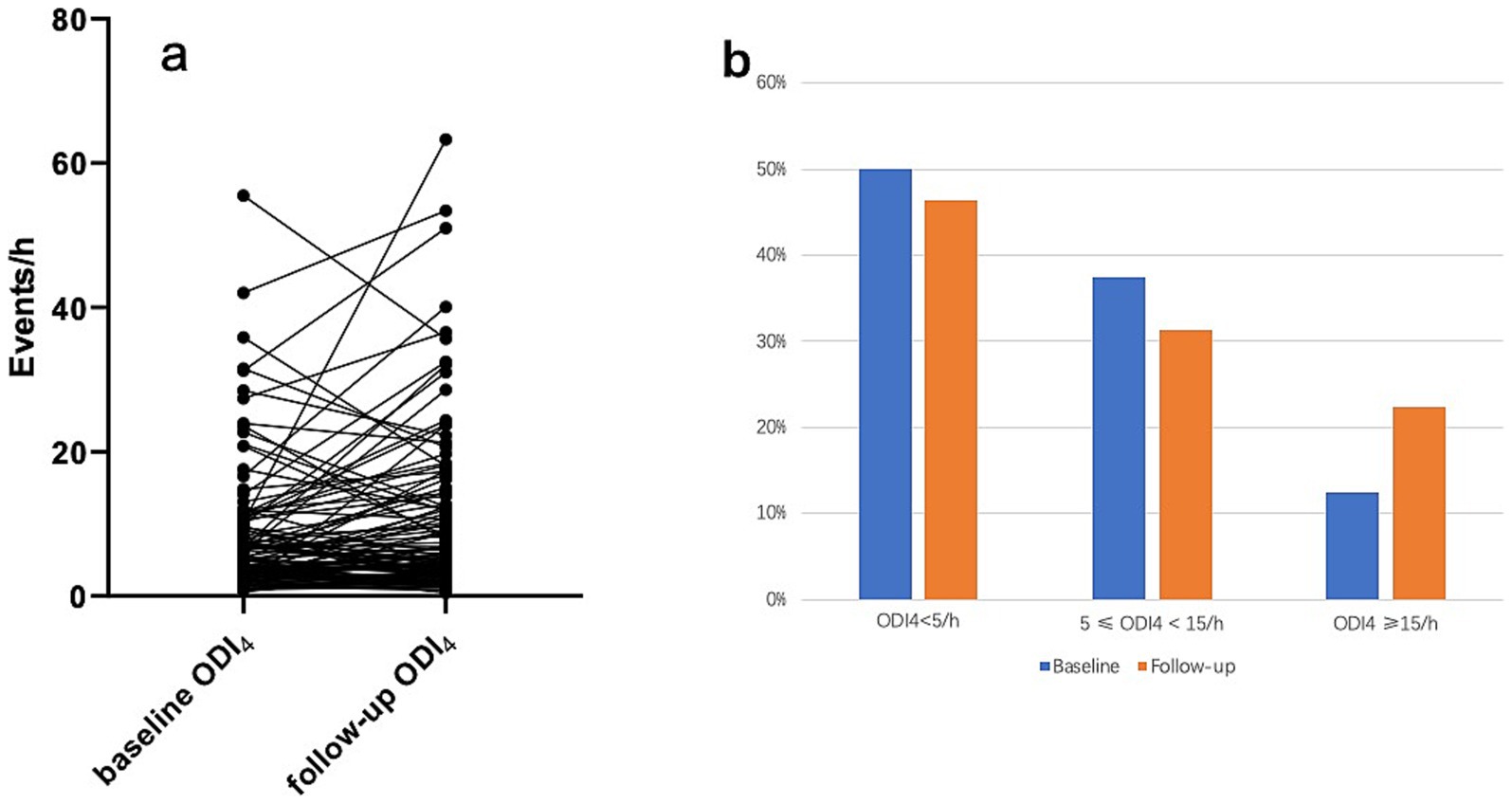
Figure 2. Changes in ODI4 of the cohort over 5 years follow-up period. (a) Change in ODI4 of each polio survivor in the cohort. (b) Proportion of participants in the cohort in different ODI4 severity group. ODI4: oxygen desaturation ≥4% index.
Change scores (Δ) were calculated as follow-up minus baseline values. To identify predictors of ODI4 change, correlation analysis evaluated ΔODI4 against age, BMI, years since polio onset, scoliosis, and baseline ODI4 (Table 2). Significant positive correlations emerged between ΔODI4 and scoliosis (r = 0.27, p = 0.005) and ΔBMI (r = 0.25, p = 0.008).
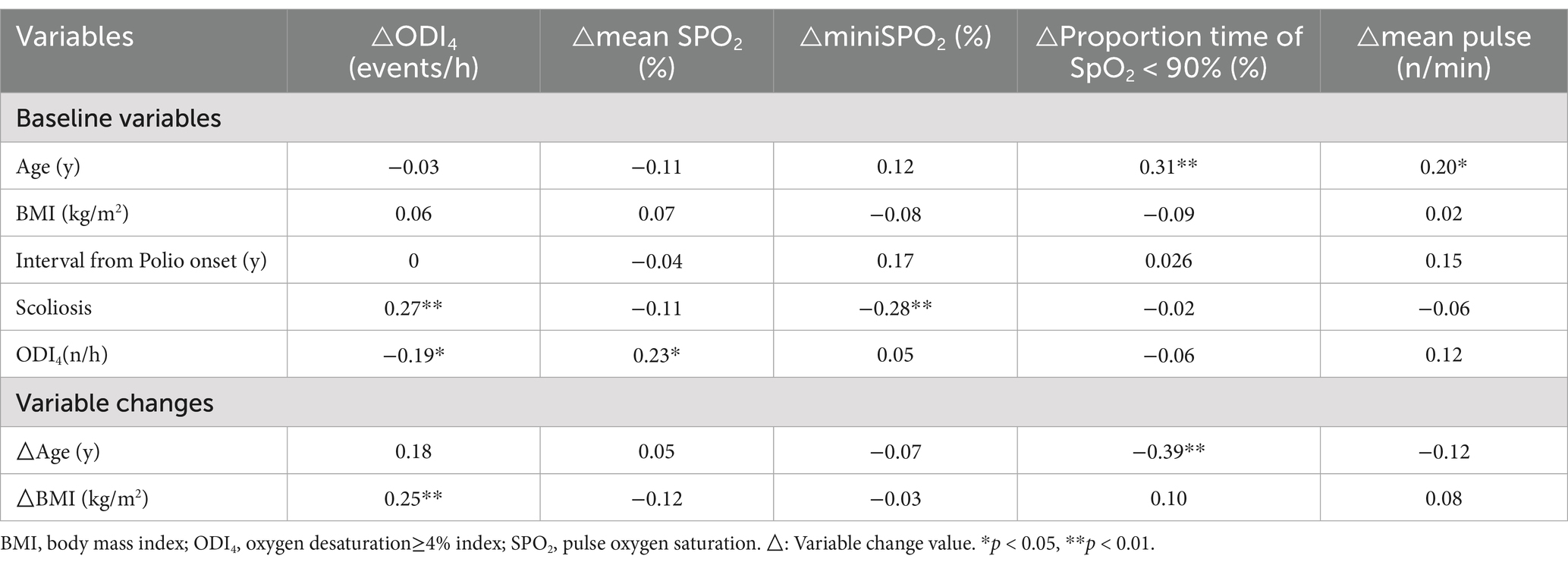
Table 2. Linear correlation coefficient between baseline clinical, anthropometric, oximeter data and the changes in oximeter data in the follow up periods.
In linear multivariate regression analyses, the change in ODI4 was significantly associated with baseline BMI, BMI changes, baseline ODI4 and scoliosis (Table 3). While other conditions remain constant, compared with patients without scoliosis, the average change in ODI4 in patients with scoliosis is 5.53 n/h higher.
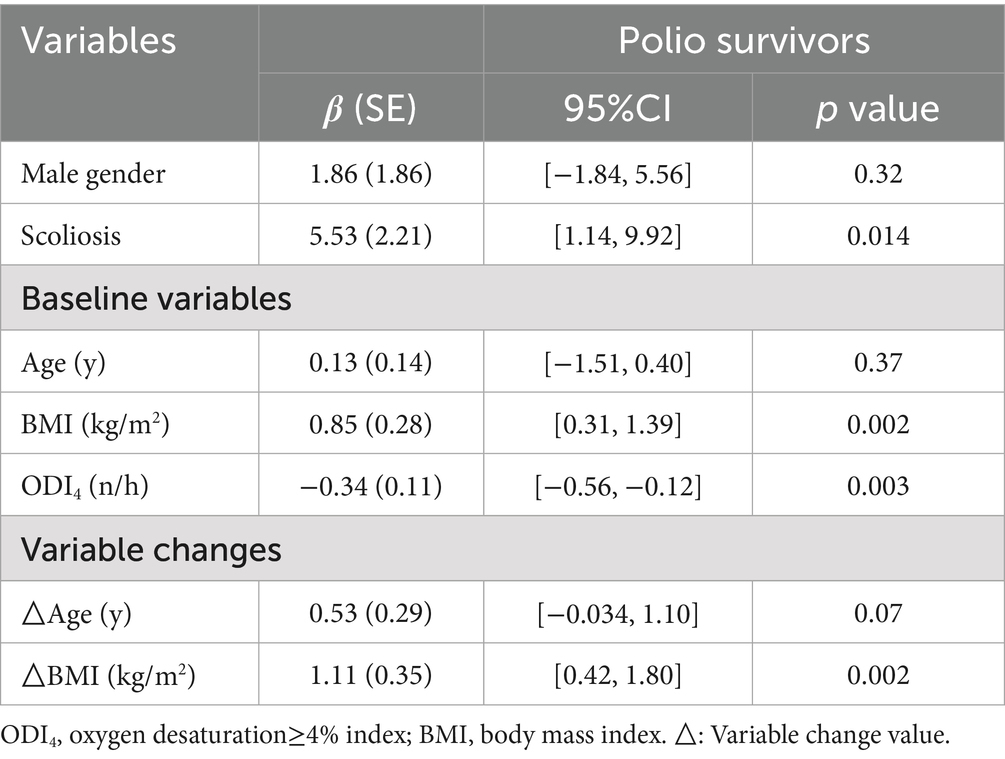
Table 3. Linear multivariate regression analyses assessing the association between the change in ODI4 and different independent variables.
The 112 survivors who completed follow-up did not differ in age, sex, or BMI from the 33 who underwent PSG follow-up. However, the PSG subgroup had higher baseline ODI4 (16.62 ± 13.1 vs. 10.35 ± 11.63 events/h, p = 0.009). Table 4 compares baseline and follow-up demographics, anthropometrics, and PSG metrics between polio survivors with PSG follow-up and controls. At baseline, groups were matched for age, sex, BMI, and AHI. The polio group exhibited higher baseline hypopnea index (p < 0.001) and greater proportion of respiratory events during REM sleep (p = 0.005).
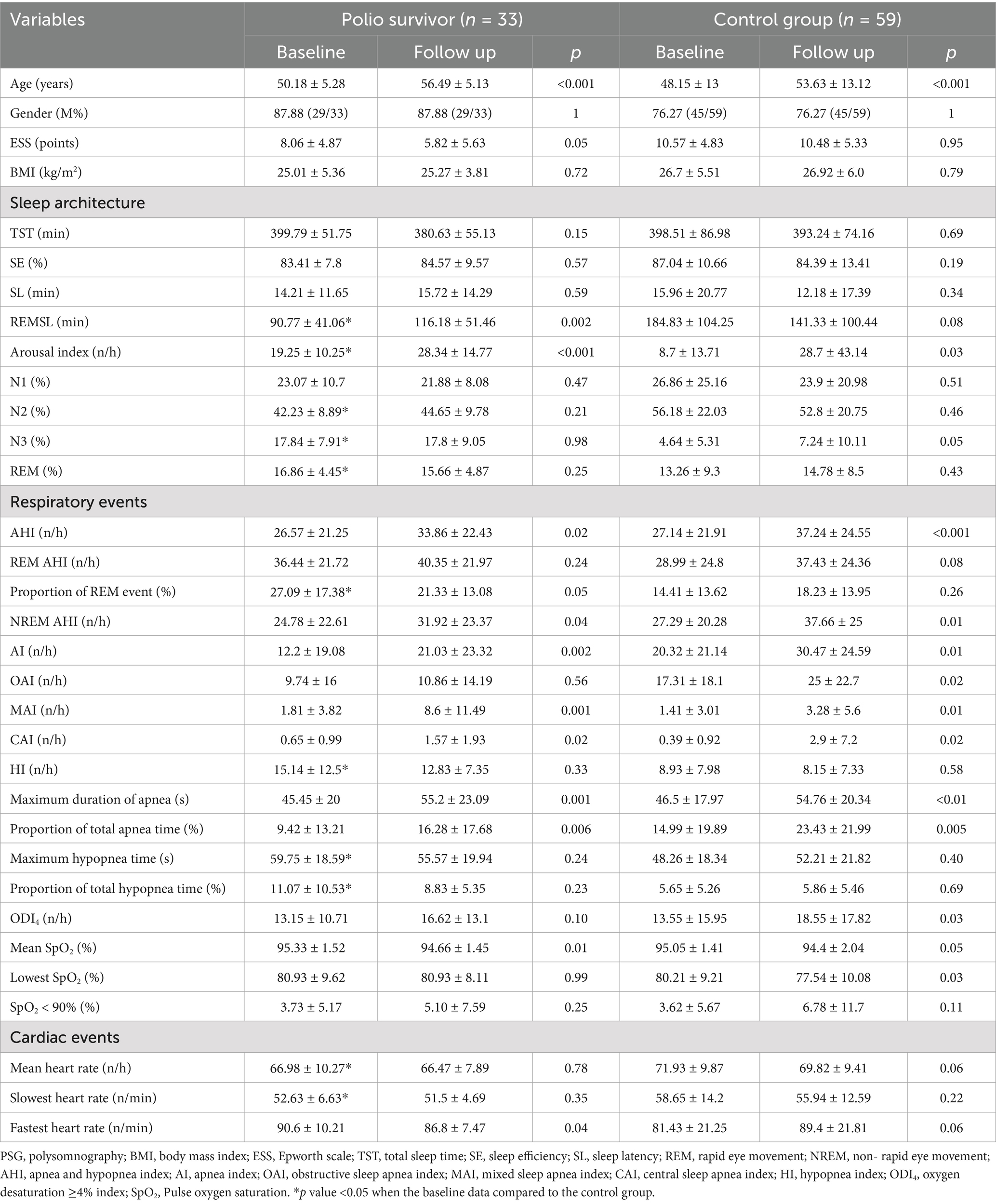
Table 4. Demographic, anthropometric and PSG data of the polio survivor cohort and the control group in the baseline and follow-up period.
In polio survivors, REM sleep latency increased significantly (p = 0.002), with a trend toward reduced REM duration. AHI rose significantly in both groups: polio survivors (26.57 ± 21.25 to 33.86 ± 22.43 n/h, p = 0.02) and controls (27.14 ± 21.91 to 37.24 ± 24.55 n/h, p = 0.004) (Figure 3). Elevated AHI occurred in 73% of polio survivors and 67% of controls. Both groups showed significant increases in maximum apnea duration and total apnea proportion, with slight trends toward reduced SpO₂. Besides, at baseline, the arousal index of polio survivors was already higher than that of the control group. After follow-up, the arousal index in both groups increased significantly.
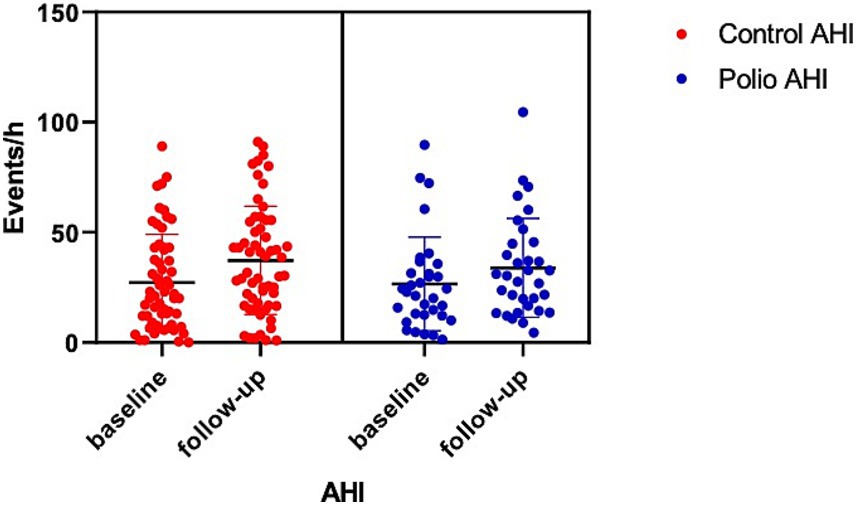
Figure 3. Comparison of AHI between baseline and follow-up in polio survivor group and control group. AHI, apnea and hypopnea index.
As shown in Table 5, ΔAHI did not differ between groups (p = 0.89). However, polio survivors exhibited a significant increase in Δ mixed sleep apnea (MSA, p = 0.02) index and ΔREM latency (p = 0.009) compared to controls.
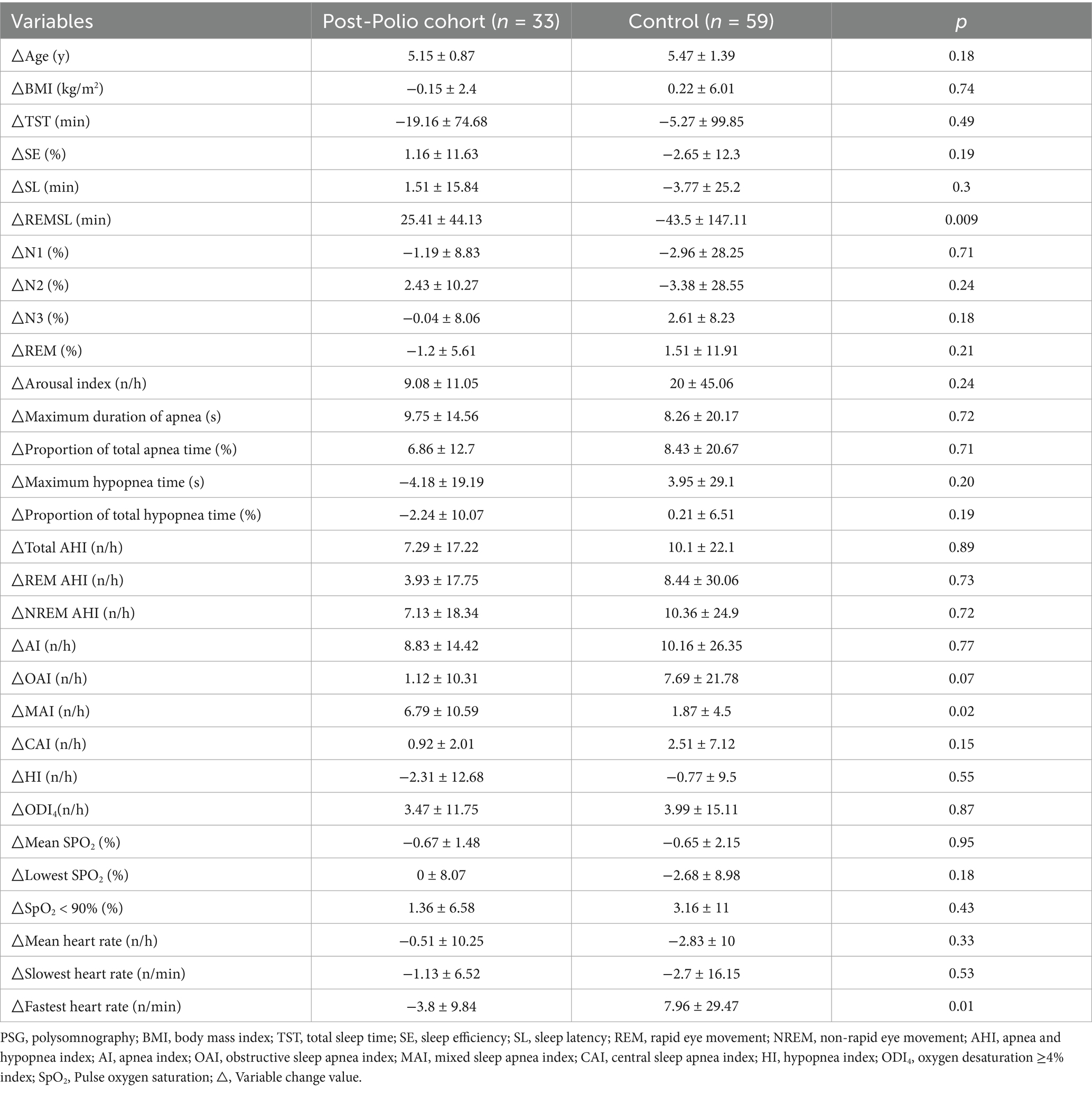
Table 5. Changes of clinical, anthropometric and PSG data between baseline and follow-up in different groups.
4 Discussion
This longitudinal study prospectively evaluated the progression of OSA in patients with polio sequelae using a community-based cohort with a mean follow-up of 5 years. Results demonstrated that ODI4, AHI, and maximum apnea duration significantly increased over time in this patient population. Notably, changes in ODI4 were positively correlated with changes in BMI and scoliosis.
Several studies have demonstrated that AHI increases progressively over time and that the progression of OSA is correlated with age, male gender, and BMI in the general population (11–13). Mechanistically, older OSA patients have a higher propensity for upper airway collapse than younger ones due to genioglossus neurogenic degeneration and diminished ventilatory sensitivity to oxygen/CO₂ with aging (14–16). Obesity remains the most critical risk factor for OSA progression, as adipose tissue accumulation in the tongue and pharyngeal regions reduces upper airway caliber and enhances collapsibility during sleep (12, 17). Peri-pharyngeal fat deposition additionally contributes to anatomical narrowing of the upper airway (18, 19). However, in aging polio patients, BMI alone may not adequately predict OSA risk due to muscle atrophy-induced weight loss. A shift from muscle to fat mass in these individuals might instead facilitate OSA development (2), highlighting the need for age- and disease-specific risk assessment metrics.
In patients with polio sequelae, residual neuromuscular impairments may promote OSA through multiple mechanisms. Bulbar involvement contributes to hypopharyngeal collapse via hypotonia of upper airway dilator muscles, predisposing patients to obstructive events during sleep (20). Neuromuscular scoliosis and chest wall deformities alter diaphragmatic mechanics, reducing its efficiency in counteracting upper airway collapse (8). Consistent with our findings, results show that changes in ODI4 are associated with scoliosis.
Based on the predisposing factors of polio sequelae, we hypothesized that OSA progression in these patients might be more severe than in the general population. However, no statistically significant difference in AHI progression was observed between the polio sequelae group and controls. This may first be attributed to stabilized neurological damage from polio, which does not accelerate its progression. Additionally, our sample comprised community-dwelling patients with relatively mild polio and preserved pulmonary function. We cannot exclude that the follow-up duration was insufficient to detect differences.
Among respiratory events, the dominant types were obstructive apnea and hypopnea, consistent with prior data from Dahan et al. (9) and Hsu et al. (8). At follow-up, the MSA index increased significantly in the polio sequelae group compared to controls. MSA is known to correlate with respiratory control system instability, OSA severity, age, male sex, and obesity (21). Long-term intermittent hypoxia—particularly in severe OSA—may impair respiratory center function through repeated hypoxic stress (22). Thus, the elevated MSA index in this cohort likely reflects worsening OSA. Besides, the high variability in respiratory muscle paresis distribution and bulbar involvement could explain the broad spectrum of SDB pattern observed among polio survivors (4). Further investigation is warranted to clarify these mechanisms.
In the post-polio cohort, we observed a significant increase in REM latency and a trend decrease in REM duration compared to controls, consistent with prior reports of delayed REM sleep onset and reduced REM duration in polio sequelae patients (23). It’s hypothesized that bulbar involvement may indicate additional brainstem poliovirus tropism (particularly in the reticular formation), potentially disrupting REM sleep initiation mechanisms (23). The arousal index was higher in post-polio cohort at baseline. Sliva et al. (24) reported that post-polio patients presented lower sleep efficiency, higher arousal index, higher REM latency and a larger number of stage changes. The increase in the arousal index may be related to factors such as abnormal limb sensations, OSA, and periodic limb movements (PLM). Unfortunately, due to problems like muscle atrophy in this post-polio group, PLM signals could not be accurately identified. Although no significant group difference was found in AHI progression, the elevated proportion of MSA and prolonged REM latency in post-polio patients highlight the characteristics of sleep-disordered breathing compared to controls.
This study has several limitations, including a small sample size, loss to follow-up, and a relatively short follow-up period. Especially a small sample size leads to insufficient statistical power, large sampling errors, poor stability and representativeness of results, making it difficult to detect true differences and limiting extrapolation; it also increases sensitivity to missing data, raises bias risks, and reduces research reliability. Owing to mobility constraints and limited PSG accessibility, the oxygen desaturation index ODI4 was employed as a surrogate metric. As reported, when incorporating AHI data from PSG, ODI4 demonstrates the highest accuracy in diagnosing and classifying the severity of OSA during nocturnal SpO₂ analysis (25). Although ODI4 is less sensitive and specific than the AHI, it reliably tracks longitudinal disease progression. To validate this, we conducted targeted PSG follow-ups where feasible, confirming concordant trends between AHI and ODI4 trajectories. Besides, although the sample undergoing PSG follow-up did not differ in age, sex, or BMI from the oximetry group, the PSG subgroup had higher baseline ODI4 (16.62 ± 13.1 vs. 10.35 ± 11.63 events/h, p = 0.009). There may be selection bias in the sample undergoing PSG follow-up. Because patients with more severe symptoms are more willing to complete in-lab PSG monitoring, the PSG subgroup may fail to accurately reflect the overall changing trends due to more severe baseline OSA. While BMI and scoliosis alone may not fully characterize OSA risk in this population, data limitations—such as the absence of neck circumference measurements and electromyography (EMG) assessments—may have affected the study’s validity. And due to the cross-sectional of the control data, comorbidities such as asthma and diabetes, which can affect the progression of OSA, were not matched. These may also lead to bias in the results.
5 Conclusion
This study demonstrates that OSA-related parameters, particularly mixed apnea and REM alterations, progress differently in polio survivors. Changes in ODI4 were positively correlated with BMI fluctuations and scoliosis. Despite declining poliomyelitis incidence over recent decades, polio sequelae remain prevalent in aging post-polio populations, posing an escalating challenge for clinical care. Prospective longitudinal follow-up studies with larger samples are needed to inform patient management and optimize treatment strategies.
Data availability statement
The raw data supporting the conclusions of this article will be made available by the authors, without undue reservation.
Ethics statement
The studies involving humans were approved by this study was approved by the institutional review board of Binzhou Medical University (2012 Academy Ethics No. 1), and all subjects signed the informed consent form. The studies were conducted in accordance with the local legislation and institutional requirements. The participants provided their written informed consent to participate in this study.
Author contributions
QD: Data curation, Conceptualization, Investigation, Writing – original draft. XL: Writing – original draft, Data curation. MW: Writing – original draft, Data curation. JWa: Data curation, Writing – original draft. TS: Data curation, Writing – original draft. YS: Data curation, Writing – original draft. JLiu: Data curation, Writing – original draft. YY: Data curation, Writing – original draft. JWu: Writing – original draft, Data curation. JD: Writing – original draft, Data curation. XD: Supervision, Writing – review & editing, Validation. CZ: Writing – review & editing, Methodology. YZ: Writing – original draft, Data curation. LZ: Data curation, Writing – original draft. JLi: Writing – original draft, Data curation. CL: Writing – review & editing, Validation. KS: Validation, Writing – review & editing. FH: Writing – review & editing, Supervision.
Funding
The author(s) declare that financial support was received for the research and/or publication of this article. This study was supported by the Science and Technology Innovation 2030-Major Projects, 2021ZD0203400.
Acknowledgments
We would also like to offer special thanks to the subjects who participated in the study. The local office of the Organization for Disabled People is also gratefully acknowledged.
Conflict of interest
The authors declare that the research was conducted in the absence of any commercial or financial relationships that could be construed as a potential conflict of interest.
Generative AI statement
The authors declare that no Gen AI was used in the creation of this manuscript.
Any alternative text (alt text) provided alongside figures in this article has been generated by Frontiers with the support of artificial intelligence and reasonable efforts have been made to ensure accuracy, including review by the authors wherever possible. If you identify any issues, please contact us.
Publisher’s note
All claims expressed in this article are solely those of the authors and do not necessarily represent those of their affiliated organizations, or those of the publisher, the editors and the reviewers. Any product that may be evaluated in this article, or claim that may be made by its manufacturer, is not guaranteed or endorsed by the publisher.
Abbreviations
AASM, American Academy of Sleep Medicine; AHI, apnea and hypopnea index; AI, apnea index; CAI, central sleep apnea index; ESS, Epworth Sleepiness Scale; HI, hypopnea index; MAI, mixed sleep apnea index; MSA, mixed sleep apnea; NREM, non-rapid eye movement; OAI, obstructive sleep apnea index; ODI4, oxygen desaturation ≥4% index; OSA, obstructive sleep apnea; PSG, polysomnography; REM, rapid eye movement; SE, sleep efficiency; SL, sleep latency; SpO2, Pulse oxygen saturation; TST, total sleep time.
References
1. Ji, G: Communiqué on major data of the second National Sample Survey of people with disabilities (no. 2). Chinese Disabled (2007) 12–13. (in Chinese).
2. Ulfberg, J, Jönsson, R, and Ekeroth, G. Sleep apnea syndrome among poliomyelitis survivors. Neurology. (1997) 49:1189–90. doi: 10.1212/WNL.49.4.1189-a
3. Bach, JR, and Tilton, M. Pulmonary dysfunction and its management in post-polio patients. NeuroRehabilitation. (1997) 8:139–53. doi: 10.3233/NRE-1997-8207
4. Leotard, A, Levy, J, Hartley, S, Pages, A, Genet, F, Lofaso, F, et al. Sleep disorders in aging polio survivors: a systematic review. Ann Phys Rehabil Med. (2020) 63:543–53. doi: 10.1016/j.rehab.2019.10.007
5. Redline, S, Schluchter, MD, Larkin, EK, and Tishler, PV. Predictors of longitudinal change in sleep-disordered breathing in a nonclinic population. Sleep. (2003) 26:703. doi: 10.1093/sleep/26.6.703
6. Newman, AB, Foster, G, Givelber, R, Nieto, FJ, Redline, S, and Young, T. Progression and regression of sleep-disordered breathing with changes in weight: the sleep heart health study. Arch Intern Med. (2005) 165:2408–13. doi: 10.1001/archinte.165.20.2408
7. Dean, E, Ross, J, Road, JD, Courtenay, L, and Madill, KJ. Pulmonary function in individuals with a history of poliomyelitis. Chest. (1991) 100:118–23. doi: 10.1378/chest.100.1.118
8. Hsu, AA, and Staats, BA. "Postpolio" sequelae and sleep-related disordered breathing. Mayo Clin Proc. (1998) 73:216–24. doi: 10.4065/73.3.216
9. Dahan, V, Kimoff, RJ, Petrof, BJ, Benedetti, A, Diorio, D, and Trojan, DA. Sleep-disordered breathing in fatigued postpoliomyelitis clinic patients. Arch Phys Med Rehabil. (2006) 87:1352–6. doi: 10.1016/j.apmr.2006.07.256
10. Berry, RB, Brooks, R, Gamaldo, CE, Harding, SM, Marcus, C, and Vaughn, BV. The AASM manual for the scoring of sleep and associated events: rules, terminology, and technical specifications. Westchester, IL: American Academy of Sleep Medicine (2016).
11. Leppanen, T, Toyras, J, Mervaala, E, Penzel, T, and Kulkas, A. Severity of individual obstruction events increases with age in patients with obstructive sleep apnea. Sleep Med. (2017) 37:32–7. doi: 10.1016/j.sleep.2017.06.004
12. Peppard, PE, Young, T, Palta, M, Dempsey, J, and Skatrud, J. Longitudinal study of moderate weight change and sleep-disordered breathing. JAMA. (2000) 284:3015–21. doi: 10.1001/jama.284.23.3015
13. Sahlman, J, Pukkila, M, Seppa, J, and Tuomilehto, H. Evolution of mild obstructive sleep apnea after different treatments. Laryngoscope. (2007) 117:1107–11. doi: 10.1097/MLG.0b013e3180514d08
14. Edwards, BA, Wellman, A, Sands, SA, Owens, RL, Eckert, DJ, White, DP, et al. Obstructive sleep apnea in older adults is a distinctly different physiological phenotype. Sleep. (2014) 37:1227–1236A. doi: 10.5665/sleep.3844
15. Kronenberg, RS, and Drage, CW. Attenuation of the ventilatory and heart rate responses to hypoxia and hypercapnia with aging in normal men. J Clin Invest. (1973) 52:1812–9. doi: 10.1172/JCI107363
16. Saboisky, JP, Stashuk, DW, Hamilton-Wright, A, Trinder, J, Nandedkar, S, and Malhotra, A. Effects of aging on genioglossus motor units in humans. PLoS One. (2014) 9:e104572. doi: 10.1371/journal.pone.0104572
17. Shah, N, and Roux, F. The relationship of obesity and obstructive sleep apnea. Clin Chest Med. (2009) 30:455–65. doi: 10.1016/j.ccm.2009.05.012
18. Chang, K-H, Lai, C-H, Chen, S-C, Hsiao, W-T, Liou, T-H, and Lee, C-M. Body composition assessment in Taiwanese individuals with poliomyelitis. Arch Phys Med Rehabil. (2011) 92:1092–7. doi: 10.1016/j.apmr.2011.01.019
19. Festvag, L, Schanke, A-K, Gilhus, NE, Aarrestad, S, Lofthus, K, Johnsen, S, et al. Health and social conditions in Norwegian polio survivors: a 20-year follow-up study. J Rehabil Med. (2016) 48:688–95. doi: 10.2340/16501977-2118
20. Aboussouan, LS, and Mireles-Cabodevila, E. Sleep-disordered breathing in neuromuscular disease: diagnostic and therapeutic challenges. Chest. (2017) 152:880–92. doi: 10.1016/j.chest.2017.03.023
21. Yamauchi, M, Tamaki, S, Yoshikawa, M, Ohnishi, Y, Nakano, H, Jacono, FJ, et al. Differences in breathing patterning during wakefulness in patients with mixed apnea-dominant vs obstructive-dominant sleep apnea. Chest. (2011) 140:54–61. doi: 10.1378/chest.10-1082
22. Shoseyov, D, Cohen-Kaufman, T, Schwartz, I, and Portnoy, S. Comparison of activity and fatigue of the respiratory muscles and pulmonary characteristics between post-polio patients and controls: a pilot study. PLoS One. (2017) 12:e0182036. doi: 10.1371/journal.pone.0182036
23. Siegel, H, McCutchen, C, Dalakas, MC, Freeman, A, Graham, B, Alling, D, et al. Physiologic events initiating REM sleep in patients with the postpolio syndrome. Neurology. (1999) 52:516–22. doi: 10.1212/WNL.52.3.516
24. Silva, TM, Moreira, GA, Quadros, AA, Pradella-Hallinan, M, Tufik, S, and Oliveira, AS. Analysis of sleep characteristics in post-polio syndrome patients. Arq Neuropsiquiatr. (2010) 68:535–40. doi: 10.1590/s0004-282x2010000400011
Keywords: neuromuscular disease, community-living polio survivor, obstructive sleep apnea syndrome, polysomnography, oximetry
Citation: Ding Q, Li X, Wang M, Wang J, Sun T, Sun Y, Liu J, Yu Y, Wu J, Du J, Dong X, Zhang C, Zuo Y, Zhao L, Li J, Lv C, Strohl KP and Han F (2025) Obstructive sleep apnea in community-dwelling polio survivors: a 5-year longitudinal follow-up study. Front. Neurol. 16:1643862. doi: 10.3389/fneur.2025.1643862
Edited by:
Jason H. Huang, Baylor Scott and White Health, United StatesCopyright © 2025 Ding, Li, Wang, Wang, Sun, Sun, Liu, Yu, Wu, Du, Dong, Zhang, Zuo, Zhao, Li, Lv, Strohl and Han. This is an open-access article distributed under the terms of the Creative Commons Attribution License (CC BY). The use, distribution or reproduction in other forums is permitted, provided the original author(s) and the copyright owner(s) are credited and that the original publication in this journal is cited, in accordance with accepted academic practice. No use, distribution or reproduction is permitted which does not comply with these terms.
*Correspondence: Qidi Ding, ZGluZ3FpZGk0Njc3QDE2My5jb20=
 Qidi Ding
Qidi Ding Xiao Li2
Xiao Li2 Ting Sun
Ting Sun Yan Yu
Yan Yu Chi Zhang
Chi Zhang Changjun Lv
Changjun Lv Kingman P. Strohl
Kingman P. Strohl Fang Han
Fang Han